Long Distance Running Efficiency, Economy Does not Decline with Age
It would seem obvious that the efficiency shown by older runners would decline with age and that this would partially explain the decline in performance with age.
Studies have shown that the performance of senior male and female athletes declines about 3.4% per year , initially slowly from age 50 to 75 years and more dramatically after and age or 75 years.
Men showed no difference in decline of sprint and endurance events, whereas the sprint decline was greater than in endurance events for women, especially after the age of 75 years.
However recent research has shown that this decline in performance was not due to a deterioration in the efficiency with which older runners ran.
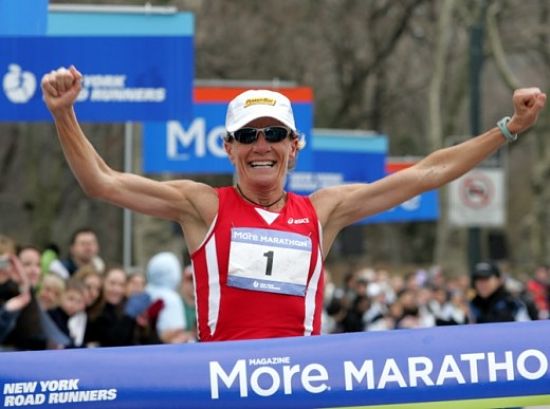
Research Study Findings
Investigators studied a total of 51 competitive athletes, who ranged in age from 18 years to 77 years of age.
The study was published in the Journal of Strength and Conditioning Research.
Each runner was super fit and trained regularly and was the best of the best, with a top three placing in their age group for the local 10-kilometer or 5-kilometer road races.
Their running efficiency was measured by how much oxygen an athlete consumed to run at a particular speed. The key findings were:
► Economical and fit runners will be less constrained by restrictions in oxygen uptake rates and will outdistance and run faster over long distances.
► Contrary to expectations, efficiency did not decline with age. Older athletes consumed similar amounts of oxygen at the same speed as younger athletes.
► Exercise economy (i.e. metabolic cost of sustained sub-maximal exercise) does not change with age in endurance-trained adults.
► However, older runners are slower overall than younger runners.
Performance Limitation of Older Athletes
Their VO2 max, which is a measure of the body's capacity to use oxygen during exercise and transport it, was significantly lower in older athletes as was their maximal heart rates.
These two things set limits on their maximum performance.
► At moderate speeds they are just as efficient, but they cannot sustain the higher speeds that they used to do as young athletes.
► The progressive reduction in VO2max with age appears to be the primary mechanism accompanied by decreases in the maximal stroke volume and heart rate. See: Endurance exercise performance in Masters athletes: age-associated changes and underlying physiological mechanisms.
► Older athletes cannot maintain the same level of training as they did when they were younger.
► This applies to the intensity (speed) and volume of the exercise that can be performed during training sessions.
Other Causes of Declining Performance with Age
The researchers also looked at other factors that may contribute to the decline in performance with age – power, strength and flexibility, to see whether these factors could perhaps explain why running performance declines with age, despite overall efficiency and economy at sub-maximal performance levels being independent of age. Their findings were:
► The older runners showed significantly worse results for all three of these measures.
► Strength in the upper-body is required to help drive runners uphill and to maintain leg turnover.
► Muscle power, which is how fast the strength is developed determines how well runners can change pace or direction or run up hills.
► Flexibility determines step frequency and stride length.
These findings should not be regarded as negative. Strength does declines with age, but the decline can be minimized and delayed by strength training.
Retention of Muscle Mass
Other studies have shown that older athletes do not show the decline in muscle mass that occurs with most people as they get older.
► It appears to be a matter of "If you don't use it - You will Lose it".
► It appears that the maximum performance of older athletes is far below their potential.
► The average finishing time for the fastest group of men older than 60 in the New York Marathon has dropped by more than seven minutes over the last few years.
► For older women, the race times have declined by more than 16 minutes.
► Older runners have probably not yet reached their limits in marathon performance.
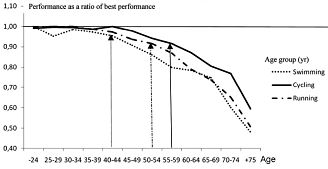
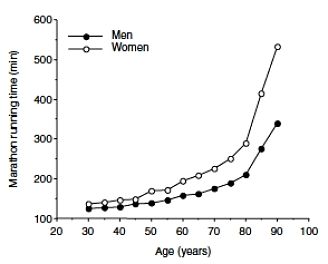
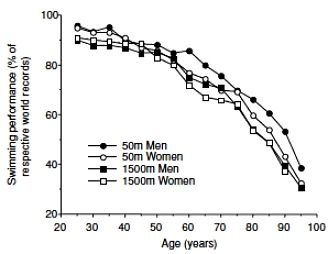
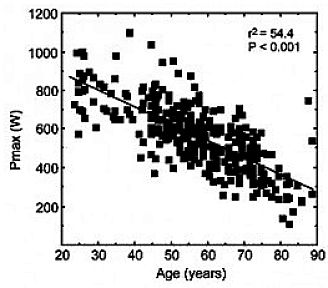
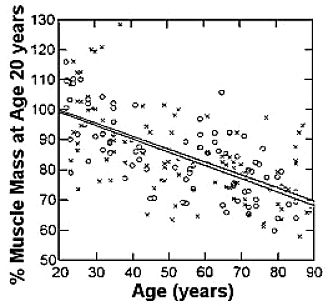
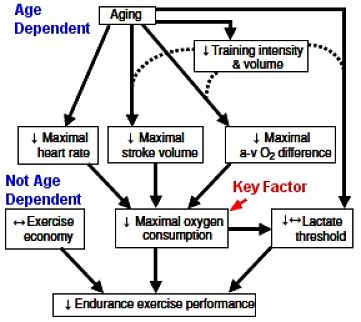
In summary, Masters endurance athletes are capable of remarkable athletic and physiological functional performance, thereby representing a uniquely positive example of 'exceptional ageing'. Nevertheless, endurance exercise performance decreases during middle-age and declines at an even more rapid rate in older age.The available data indicate that decreases in VO2 Max are the most clear and consistent contributor to these declines in performance. Reductions in the lactate threshold also may contribute. Sub-maximal exercise economy is preserved with ageing in endurance athletes. The age-associated decreases in VO2 Max in endurance exercise-trained adults are mediated by reductions in maximal cardiac output and maximal arterio-venousO2 difference,with reductions in both maximal stroke volume and heart rate contributing to the former. The decreases in endurance exercise performance and VO2 Max with ageing in endurance exercise-trained athletes are associated most closely with reductions in exercise training intensity and volume, probably as a consequence of changes in a number of physical and behavioural factors (e.g. increased prevalence of injuries, and reductions in energy, time and motivation to train).
Related Articles for Running and Injury Prevention
=> How Do You Stay Injury Free When Running, Training for Events
=> Best Tips for Jogging and Running with Dogs
=> Stretching Exercises Before a Run or Workout May NOT Reduce Injuries
=> Proven Benefits of Short, High Intensity Runs, Walks, Workouts
=> Tips for Running with Jogging Strollers: Pros and Cons, Stroller Holding Guides
=> How to Run Faster and Longer by Using your Magic Pace
=> Uphill Running Training Workouts and Intervals Plan for Speed, Endurance